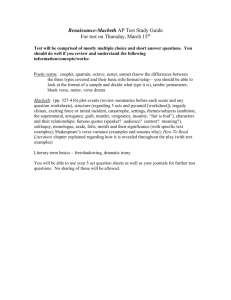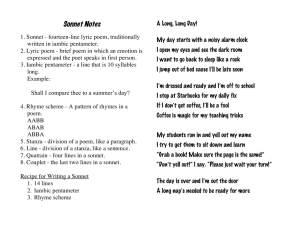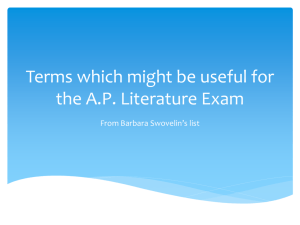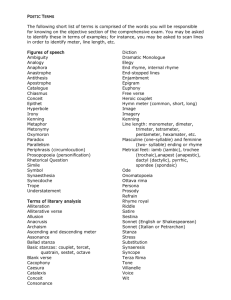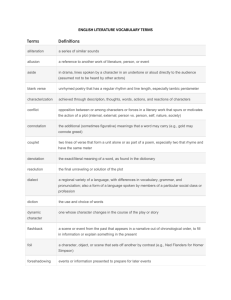Glossary of Poetry Terms
advertisement
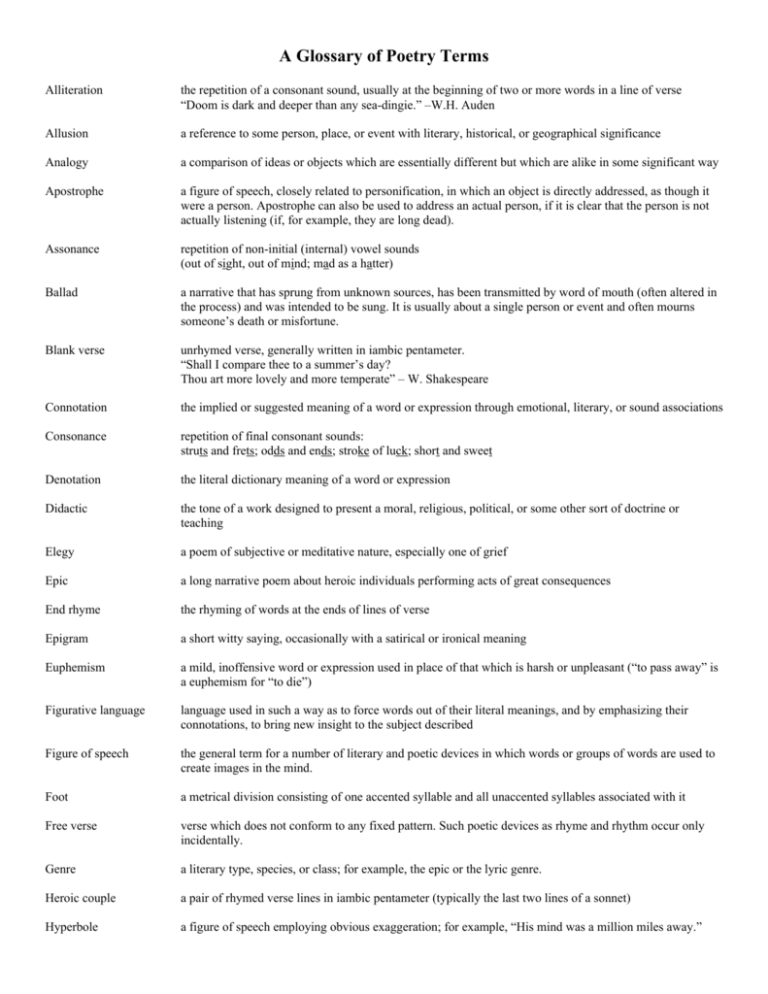
A Glossary of Poetry Terms Alliteration the repetition of a consonant sound, usually at the beginning of two or more words in a line of verse “Doom is dark and deeper than any sea-dingie.” –W.H. Auden Allusion a reference to some person, place, or event with literary, historical, or geographical significance Analogy a comparison of ideas or objects which are essentially different but which are alike in some significant way Apostrophe a figure of speech, closely related to personification, in which an object is directly addressed, as though it were a person. Apostrophe can also be used to address an actual person, if it is clear that the person is not actually listening (if, for example, they are long dead). Assonance repetition of non-initial (internal) vowel sounds (out of sight, out of mind; mad as a hatter) Ballad a narrative that has sprung from unknown sources, has been transmitted by word of mouth (often altered in the process) and was intended to be sung. It is usually about a single person or event and often mourns someone’s death or misfortune. Blank verse unrhymed verse, generally written in iambic pentameter. “Shall I compare thee to a summer’s day? Thou art more lovely and more temperate” – W. Shakespeare Connotation the implied or suggested meaning of a word or expression through emotional, literary, or sound associations Consonance repetition of final consonant sounds: struts and frets; odds and ends; stroke of luck; short and sweet Denotation the literal dictionary meaning of a word or expression Didactic the tone of a work designed to present a moral, religious, political, or some other sort of doctrine or teaching Elegy a poem of subjective or meditative nature, especially one of grief Epic a long narrative poem about heroic individuals performing acts of great consequences End rhyme the rhyming of words at the ends of lines of verse Epigram a short witty saying, occasionally with a satirical or ironical meaning Euphemism a mild, inoffensive word or expression used in place of that which is harsh or unpleasant (“to pass away” is a euphemism for “to die”) Figurative language language used in such a way as to force words out of their literal meanings, and by emphasizing their connotations, to bring new insight to the subject described Figure of speech the general term for a number of literary and poetic devices in which words or groups of words are used to create images in the mind. Foot a metrical division consisting of one accented syllable and all unaccented syllables associated with it Free verse verse which does not conform to any fixed pattern. Such poetic devices as rhyme and rhythm occur only incidentally. Genre a literary type, species, or class; for example, the epic or the lyric genre. Heroic couple a pair of rhymed verse lines in iambic pentameter (typically the last two lines of a sonnet) Hyperbole a figure of speech employing obvious exaggeration; for example, “His mind was a million miles away.” Idiom a language or manner of speaking typical of a particular region or group of people Image a general term for any representation of a particular thing with its attendant and evocative detail. It may be a metaphor, a simile, or a straight forward description. Internal rhyme rhyming of words within, rather than at the end of, lines Irony a mode of expression in which the author says one thing and means the opposite. The term also applies to a situation, or the outcome of an event (or series of events), that is contrary to what is naturally hoped or expected. Juxtaposition the placement of things side by side to bring out meaning not evident when they stand alone. (especially for contrast) Lyric any short poem that seems to be especially musical and expresses, in most instances, the poet’s clearly revealed thoughts and feelings. Metaphor an implied comparison between two things (Life is a candle) Meter any regular pattern of rhyme Metonymy the substitution of a word that relates to the thing or person to be named for the name itself. “The crown will find an heir” – W. Shakespeare (crown refers to the sovereign, the person who holds the crown) Monologue a poem or passage in a drama, in which a single character or actor speaks alone and, usually, at some length (See also soliloquies) Moral the lesson taught by a literary work Motif a recurrent element in literature; a particular theme or character that reappears in a single work or in several works Narrative poem a story told in verse form Octave a stanza consisting of eight lines; the first eight lines of a sonnet, particularly the Italian sonnet Ode a lengthy, dignified lyric poem or song expressing exalted or enthusiastic emotion, often about some person or occasion worthy of esteem Onomatopoeia the use of a word in which the sound suggests what the word designated (splash, buzz, murmur). This device enables the writer to express sense through sound. Paradox a statement which seems on the surface contradictory, yet if interpreted figuratively, it involves an element of truth: “Much madness is divinest sense . . . “ - E. Dickinson Parody a humorous imitation or burlesque of a serous piece of literature or writing Pastoral literature dealing with rural life, usually in a sympathetic fashion Pathos that quality in prose or poetry that evokes in the reader a feeling of pity and compassion Pentameter metrical line of five feet Personification a figure of speech in which places, things, animals, or ideas are endowed with human qualities: “The hills untied their bonnets . . . “ – E. Dickinson. Poetic justice an outcome of events that rewards the virtuous and punishes the vicious; an ending in which each character gets exactly what he deserves Proverb a brief, traditional saying Pun a play on words; the use of a word or words that are similar in form or sound different in meaning; for example, “He cashed his checks and checked his cash.” Quatrain a stanza consisting of four lines Refrain a line or a group of lines repeated at the end of each stanza in a poem; for example, the refrain “in the dust, in the cool tombs” closes each of the four stanzas of Carl Sandburg’s poem, “Cool Tombs” Run on line a line of verse in which the natural pause does not coincide with the end of the line: “I saw the first pear as it fell . . . “ H.D. Laurence Satire any piece of writing which criticizes manners, individuals, or political and social institutions, by holding them up to ridicule Scansion the analysis of the rhythmic patterns of verse; its arrangement of accented and unaccented syllables Sestet a stanza of six lines; the concluding six lines of a sonnet, particularly the Italian sonnet Simile a comparison between two things usually like or as (He is as bald as a billiard ball.) Soliloquy a dramatic convention which allows a character to speak his thoughts aloud, apparently unheard by others who may be on stage Sonnet a lyric poem with a traditional form of fourteen iambic pentameter lines Stanza a group of lines of verse, generally four or more, arranged to a fixed pattern Stereotype a character who conforms to widely accepted ideas of how a person should look, think, or act Style the distinctive manner in which the writer uses language: his choice and arrangement of words Symbol an object that stands for, or represents, an idea, belief, superstition, social or political institution, etc. A pair of scales, for example, is often a symbol for justice. Synecdoche a figure of speech in which the part stands for the whole; for example, bread to represent food (form of metaphor). “The sails came into the harbor” – meaning the ships. Tone the feeling conveyed by the author’s attitude toward his subject and the particular way in which he writes about it; the revelation of an author’s feelings through his choice of words and images and through emphasis; for example: sarcastic, sentimental, flippant Universality the quality that provides a work of art with truth and meaning beyond the time and place in work was created which that
